Indoor plants were rarely used 10 years ago in office design apart from the odd random pot plant. Now it’s a different story. Indoor plants are used to divide space, to provide privacy and acoustic diffusion between teams of people, to add colour, height and life to an otherwise sterile environment.
What Research Shows
Aside from the benefit of cleaner indoor air quality, there is now a wealth of evidence to show that the use of indoor plants can reduce stress and improve productivity.
Early studies showed that hospital patients recovered faster and with less complications if they had a view of nature from their window.
A recent three year Australian study has documented the environmental and psychological benefits achieved by adding indoor plants to a work space.1 The results showed clear reductions in feelings of stress, anxiety, depression, anger, fatigue, confusion. Overall negativity among participants with plants in their offices was reduced by 30 – 60%. And guess what? One plant was enough to make the difference.
In contrast, participants with no plants showed no significant changes over the experimental period. They did show a downwards trend towards increased feelings of stress (by around 20%). The findings confirmed the benefits indoor plants provide to staff wellbeing, which are also associated with improved work performance and productivity.
Indoor Plants + Design
 Hopefully we’ve convinced you that plants can add many benefits to your environment that affect the look and feel of the space and how the people within it feel. Now to the aesthetics - plants done properly are stylish and beautiful, but done badly they can look terrible. Our top five crimes for indoor plants are:
Hopefully we’ve convinced you that plants can add many benefits to your environment that affect the look and feel of the space and how the people within it feel. Now to the aesthetics - plants done properly are stylish and beautiful, but done badly they can look terrible. Our top five crimes for indoor plants are:
Our Top 5 Indoor Plant Crimes
- Dead plants! If you’re going to have plants select one person to look after them. Too much love can kill. Alternatively, rent your plants. Renting can be a convenient and economical solution when compared with constantly replacing dead plants.
- Incorrect plant species. Make sure you get expert advice to ensure your plant selections match the environmental criteria in terms of required lighting and water. This will make it easy to keep your plants alive!
- Too many or too high plants. Offices are not forests!
- Random hap hazard plants that have not been considered in the design. This can give a messy, cluttered look to the office environment.
- Selecting plants that have an odour or give people allergies.
Our Top 5 Indoor Plant Tips
- Consider plants from the very early stages of the design concept. This way they can be designed into the space in a way that will create maximum impact.
- Use repetition and uniformity for an architectural look that will really give WOW factor.
- Use plants as a feature wall. They can bring any space alive with colour and texture and look wonderful on masse.
- Incorporate indoor plants to provide privacy and screening.
- Plant leasing is a great service. They will be looked after, replaced, cleaned and watered regularly.
Go on, you can help green up our world. Incorporate indoor plants into your next work space, but make sure you do it well! If you would like advice, contact us. We’d love to help!
1 Professor Margaret Burchett at the University of Technology, Sydney
Some Inspiration


Every office is different, so taking a one-design-fits-all approach to any fit-out isn’t one we’d recommend. Creating a living, breathing office can do wonders for your business, but for the health of your organisation (and your plants), we suggest consulting with the professionals. If you'd like to green up your office, we're here to help.











